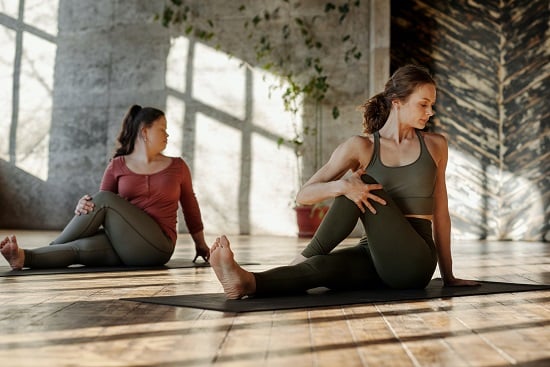Wondering, “Why do the arches of my feet hurt?” Or are you feeling tenderness in the ball of your foot? How about the sensation of paper cuts in the soles of your feet?
Unfortunately, these are some of the symptoms of plantar fasciitis, a foot condition that sends about 2 million Americans hobbling to the doctor each year.1
Plantar fasciitis occurs when the thick, fibrous band of tissue running along the sole of the foot—called the plantar fascia—becomes tight, stressed, or inflamed, leading to pain in the heel, sole, and balls of your feet.2 Because the plantar fascia supports your foot arch, it plays an important part in walking and running and can become irritated with overuse.
The good news is that effective relief can be achieved with simple treatments, starting with improving the flexibility of your feet. So, there’s no need to fret about that pain wreaking havoc from your heels to your toes—just sit back, relax, and learn how to stretch your arches with ease.
4 Stretches for Plantar Fasciitis
Despite dutifully bearing your body weight for your entire life, the plantar fascia is a finicky bit of tissue and can become inflamed if overused or damaged. Though this can make standing, walking, and running a huge pain, plantar fasciitis doesn’t have to keep you from living your life.
If you want to know how to fix high arched feet or how to lessen the foot pain you might be experiencing below are four stretches that can help alleviate aches and stings and promote mobility in your feet.
Stretch #1: The Towel Stretch
In addition to helping you sidestep suffering, this one also doubles as a good excuse for the next time your partner gets mad you’ve left your towel on the floor. Simply follow these easy steps:
- While seated, lay a towel out on the floor with one edge just beneath your toes.
- Grab the opposing ends of the towel, and pull them up toward your knees, creating a stretch in the toes.
- Hold this position for 20-30 seconds, then repeat two to three times a day.
Stretch #2: The Basic Calf Stretch
The muscles in your feet and legs are all connected to each other, which means loosening up the hamstrings, calves, and Achilles tendons can help create relief for the feet. Get the whole muscle gang involved with this basic movement that’s easy to perform anywhere.
- Place your hands against a wall, standing about an arm’s width away.
- Keeping both feet flat, slide one leg back to create a stretch in the calf. Bend the front leg to accommodate this position.
- Hold for 20-30 seconds.
- Repeat with each leg, two to three times a day.
Stretch #3: The Calf Stretch, Stair Variation
Even if you don’t typically enjoy taking the stairs, if you’re struggling with foot pain, this stretch will help make those steps worth your while. This stair variation calf stretch actually leverages your body weight to deepen the pull in the calves and improve elasticity through the heels, all the way down to your toes.
- Holding onto a railing, stand on a stair and nudge your feet back until only the balls of your feet are on the stair.
- Slowly lean to the right to put more weight on that heel, relaxing the calf muscle until you feel a gentle stretch. Hold for 20-30 seconds, then slowly tighten your calf to return to a neutral position.
- Alternate this stretch on both legs, two to three times per day.
Stretch #4: Rolling Arch Stretch
Rolling out the muscles with a foam roller or tennis ball is a stretching technique that’s long been utilized by athletes as a form of self-massage. The tension on the muscle can bust up little knots in the tissue, increase blood flow, and improve your range of movement.3
Even if you don’t have a foam roller or tennis ball, you can still take advantage of this stretching technique. Simply fill up a plastic water bottle, and pop it in the freezer overnight. Then, you can use it to get the same knot-smashing benefits, while soothing inflammation with the ice. Here’s how:
- While seated, place your frozen water bottle on the floor in front of you.
- Lift one foot and place it on the water bottle. If you can’t stand the chill, wrap the bottle in a hand towel first.
- Roll your affected foot over the bottle, using your body weight to create more tension in the arch. Focus on any areas that feel knotty or especially tender.
- Repeat for both feet as needed throughout the day.
Tips for Stretching
Although we all have a pretty good idea of what stretching looks like, it doesn’t mean we all have perfect form. Just as it’s a good idea to learn the console of a new car before taking it for a spin, it’s also smart to learn the fundamentals of how your body stretches best before jumping into any new stretching exercises or routines.
With that in mind, here are our tips for getting the most out of your movements:
- Don’t overdo it – When we want to see results fast, we try to deepen those stretches to the point of pain—which isn’t necessarily a good thing. Imagine yanking on a slightly too-small sweater until it’s lost its shape. When it comes to your foot, you should take your stretch to the point where you feel tension on the muscle but don’t feel pain in the form of paper cuts or tears. That’s your sweet spot.
- Mirror your stretching efforts – Sometimes, we feel pain worse on one side of the body than the other. In fact, it’s not uncommon for those suffering from plantar fasciitis to feel it worse in one foot. You may also notice an increased range of movement in one foot or ankle. Still, you should aim for equal stretching effort on both sides of your body.4
- Make sure to warm up – When it comes to getting the most out of your stretches, remember that you’ll achieve better results with muscles that are primed for movement instead of muscles that are cold and stiff. In other words, if you’ve been sitting at a desk all day and then try to go right into a deep lunge, you’re increasing your risk for injury. A few easy ways to get the blood pumping before you stretch include walking up a few flights of stairs, jogging in place, or performing some dynamic movements.5
Other Types of Treatment for Plantar Fasciitis
Stretching is a great way to prolong the body’s elasticity, ward off muscle imbalances, and rehab minor injuries. At the same time, there are other home remedies you can try to bring about relief from your foot pain that much faster. Check out these additional options:
- Ice your feet and take OTC pain meds – When the pain isn’t playing around, turn to ice. Not only can icing your feet help decrease inflammation, but it can also numb the area, giving the pain receptors in your heels and arches a little break. Over-the-counter NSAIDs like ibuprofen and Advil can offer similar relief, so consider doubling up on these treatments to help ease the strains of your day-to-day.
- Rest – For many folks, plantar fasciitis can actually feel the sharpest after a long night’s sleep. This is because your muscles contract while you snooze, so putting weight back on your feet when you wake up can result in sudden bouts of pain.6 While it may feel counterintuitive, cutting back on walking or running can be a healing option for those heels. You can even try pairing restful TV time with your stretching routine—your arches will thank you later.
- Find more supportive shoes – Shoes that have little to no arch support can throw off your gait and create strain on your arches, especially if you have fallen arches. Are we telling you to throw out those beachy new flip-flops? Not quite, but we do recommend only pulling them out for special occasions. If you want to know how to rebuild arches in flat feet or are just wanting extra arch support, try adding insoles to your go-to shoes. Vionic has both men’s insoles and women’s insoles that are made to maximize your foot comfort.
When Plantar Fasciitis Isn’t Plantar Fasciitis
While plantar fasciitis is one of the more common foot ailments you’re likely to run across, it’s not the only condition that can cause stabbing sensations and pain while walking. If you’ve tried stretching, icing, and NSAIDs and your pain continues to persist, a different problem may be the cause of the aggravation you feel in your soles.
Other problems that can feel like plantar fasciitis include:7
- Tarsal tunnel syndrome
- Heel fat pad syndrome
- Referred back pain
- Arthritis
- Stress fractures
While many of these issues may present the same symptoms as plantar fasciitis, they often distinguish themselves with pernicious little pains all their own. If your foot pain isn’t getting better, see a doctor or physical therapist to rule out other conditions that could come with more serious discomfort and longer rehabilitation timelines.
Stave off Foot Pain with Arch Support from Vionic
Routine stretching can help alleviate foot pain and stave off further discomfort by helping your muscles stay loose and elastic. But there are other preventative measures you can take to ensure the health and well-being of your toes, arches, and heels.
In fact, one change you can make today that won’t place a strain on your schedule is replacing your flat, unsupportive shoes with shoes that offer sufficient arch support. And that’s where Vionic comes in.
Made with exclusive alignment technology that’s podiatrist-approved, Vionic shoes can correct pronation and promote full-body alignment for a more balanced—and stylish—you. Explore our entire collection to find the pair of shoes that will keep pain at bay and put the pep back into your step.
Sources:
- Searing, Linda. “The Big Number: 2 million Americans Get Treated for Heel Pain Caused by Plantar Fasciitis.” The Washington Post. 25 November, 2019. https://www.washingtonpost.com/health/the-big-number-2-million-americans-get-treated-for-heel-pain-caused-by-plantar-fasciitis/2019/11/22/0dfe89e8-0c7a-11ea-97ac-a7ccc8dd1ebc_story.html
- Trijan, Thomas. “Plantar Fasciitis.” American Family Physician. 15 June, 2019. https://www.aafp.org/pubs/afp/issues/2019/0615/p744.html
- “5 Foam Rolling Exercises for Skeptics.” The New York Times. https://www.nytimes.com/2022/07/13/well/foam-rolling-exercises.html
- “Stretching.” Kids Health. https://kidshealth.org/en/teens/stretching.html
- “Six tips for safe stretches.” Harvard Health. https://www.health.harvard.edu/staying-healthy/six-tips-for-safe-stretches
- “Easing the pain of plantar fasciitis.” Harvard Health. https://www.health.harvard.edu/newsletter_article/easing_the_pain_of_plantar_fasciitis
- Adams, Chris. “Conditions Often Mistaken for Plantar Fasciitis.” ThoughtCo. 15 August, 2019. https://www.thoughtco.com/conditions-mistaken-for-plantar-fasciitis-1206065





Leave a Reply